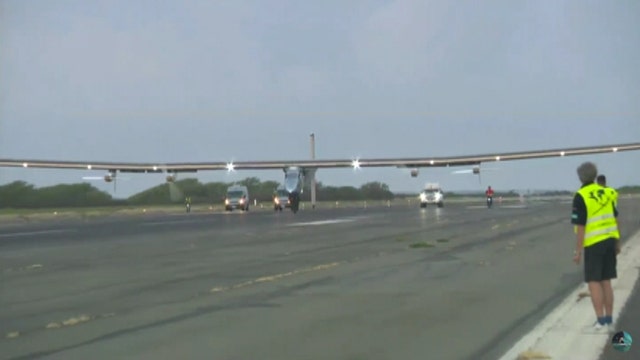Solar-powered plane lands in Hawaii after flight from Japan
Completes latest leg of round-the-world journey
Solar Impulse 2 landed in Hawaii Friday, ending its epic 4,480-mile journey from Japan after five days of solar-powered flight.
The fuel-free flight from Nagoya to Honolulu’s Kalaeloa Airport was the longest and riskiest leg of Solar Impulse 2’s round-the-world odyssey. Solar Impulse 2 touched down just before noon ET, completing its incredible trip across a vast expanse of ocean in 118 hours.
Piloted by Andre Borschberg, the single-seater plane has shattered a series of aviation records since taking off from Japan on Sunday.
Related: Solar Impulse 2’s epic journey in pictures
On Tuesday Solar Impulse 2 broke the record for longest solar-powered flight in terms of distance and duration, easily surpassing the 1,491-mile, 44-hour record Borschberg set when flying from China to Japan on the previous leg of the trip. The following day Borschberg also broke the record for longest non-stop solo flight without refueling, which previously stood at 76 hours and 45 minutes.
However, the flight has posed huge mental and physical challenges for Borschberg. The former Swiss military pilot has navigated difficult weather conditions and battled exhaustion from the plane’s cramped cockpit, which is too small to stand in.
Related: Solar Impulse 2 passes ‘point of no return’ in audacious attempt to cross the Pacific
Solar Impulse 2, a larger version of a single-seat prototype that first flew five years ago, is made of carbon fiber and has 17,248 solar cells built into the wing that supply the plane with renewable energy, via four motors. The solar cells recharge four lithium polymer batteries, which provide power for night flying.
The aircraft typically flies between 30 mph and 40 mph, although this can increase and decrease significantly depending on wind speed.
The plane is the brainchild of explorer and Solar Impulse Chairman Bertrand Piccard, who is taking it in turns with his fellow Swiss pilot Borschberg to fly the solar-powered aircraft on its five-month-journey across the globe.
Piccard told FoxNews.com that Solar Impulse 2 proves the potential of renewable energy and clean technology. “This was my vision when I created that project – it was to have an airplane that can fly with no fuel,” he said, during a phone interview earlier this week. “This is fantastic, to prove that clean technology can achieve [the] impossible.”
The Solar Impulse chairman also believes that the solar plane could spark increased interest in technologies such as LED lights and electric cars, as well as lightweight vehicles.
Solar Impulse 2 set off from Abu Dhabi in March, and has stopped in Oman, India, Myanmar and Nanjing, China, en route to an unscheduled stop in Nagoya, Japan.
The plane originally left Nanjing, China, for Hawaii, but diverted to Japan on June 1 because of unfavorable weather ahead. It had been waiting for the right conditions to depart before Sunday’s takeoff for Hawaii.
After Hawaii, the second Pacific leg of the journey will take the plane to Phoenix. Solar Impulse 2 is slated to stop in New York before flying over the Atlantic Ocean. It will then stop in southern Europe or North Africa, depending on weather conditions.
Follow James Rogers on Twitter @jamesjrogers





















